Analyzing Content and Process Theories of Motivation Essay
VerifiedAdded on 2022/06/01
|6
|1357
|57
Essay
AI Summary
This essay provides an in-depth analysis of motivational theories, specifically focusing on content and process theories. It contrasts and compares equity theory, a process theory emphasizing equal treatment, with Maslow's hierarchy of needs, a content theory that categorizes employee needs into a hierarchy. The essay explores how these theories influence individual behavior and contribute to workplace motivation. It highlights the similarities and differences between the two theories, providing examples of companies like Tesco and Nestle that apply these principles. The essay concludes by emphasizing the importance of considering both content and process theories to foster a positive work environment and satisfy employee needs, ultimately leading to organizational success. References are included to support the arguments presented.
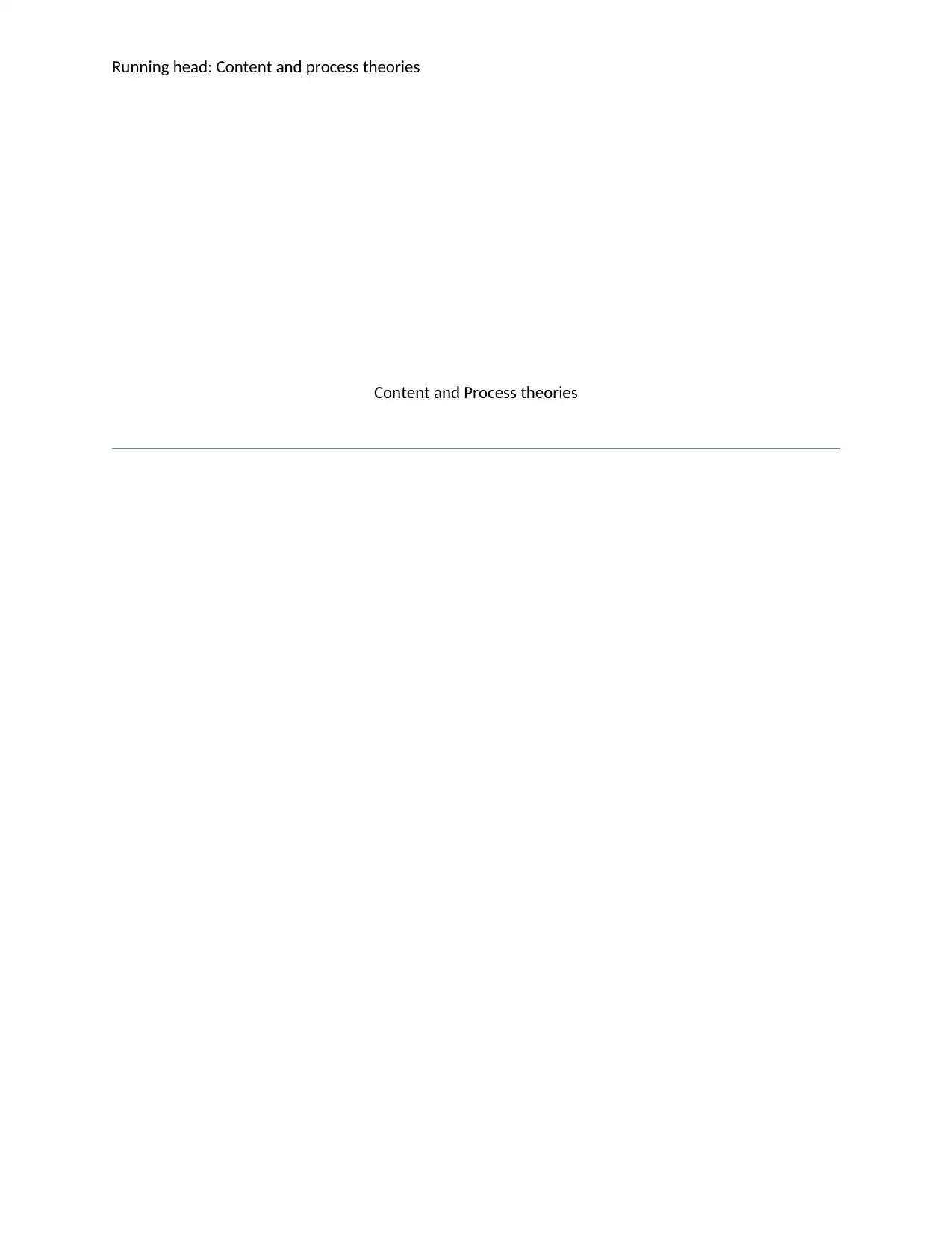
Running head: Content and process theories
Content and Process theories
Content and Process theories
Paraphrase This Document
Need a fresh take? Get an instant paraphrase of this document with our AI Paraphraser
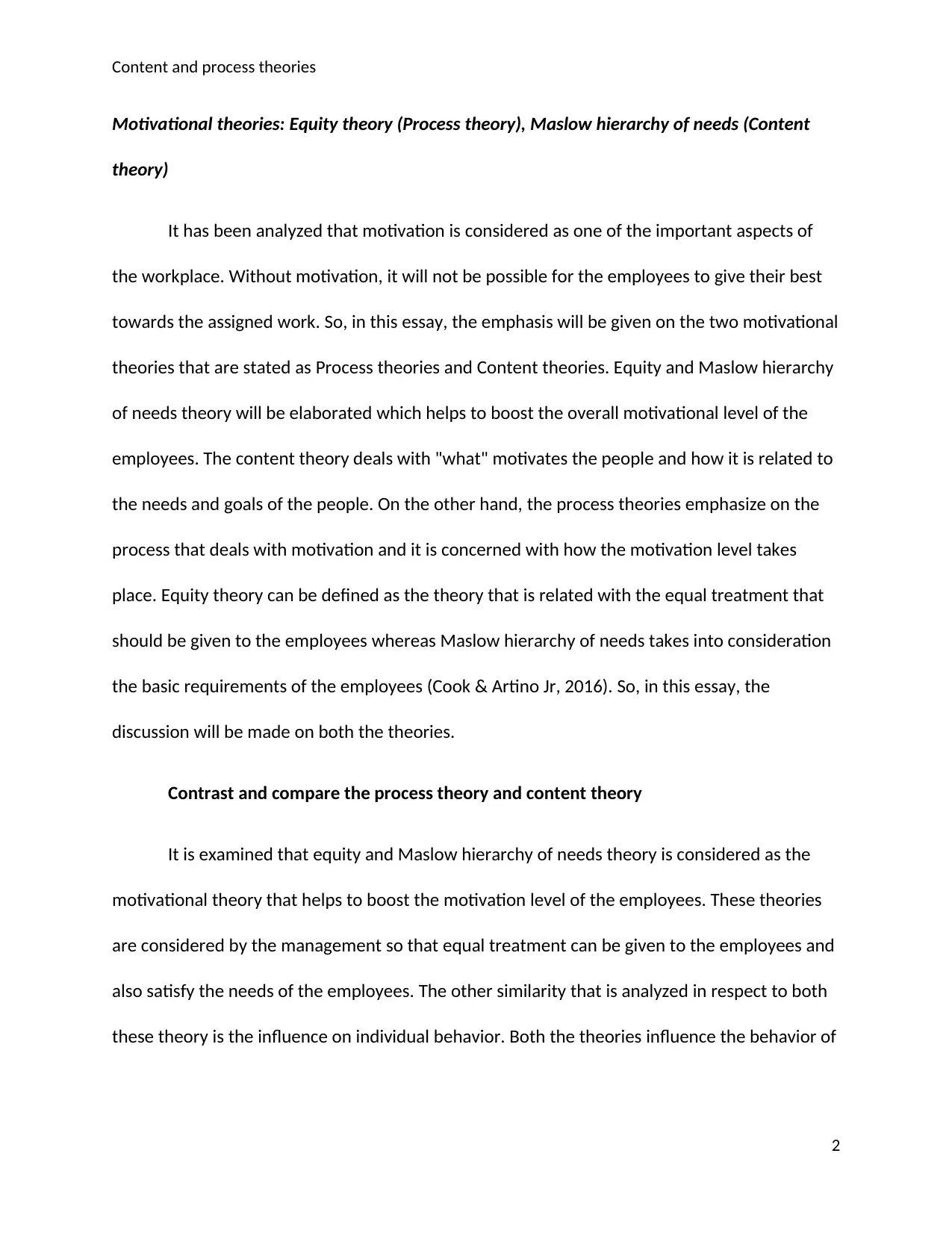
Content and process theories
Motivational theories: Equity theory (Process theory), Maslow hierarchy of needs (Content
theory)
It has been analyzed that motivation is considered as one of the important aspects of
the workplace. Without motivation, it will not be possible for the employees to give their best
towards the assigned work. So, in this essay, the emphasis will be given on the two motivational
theories that are stated as Process theories and Content theories. Equity and Maslow hierarchy
of needs theory will be elaborated which helps to boost the overall motivational level of the
employees. The content theory deals with "what" motivates the people and how it is related to
the needs and goals of the people. On the other hand, the process theories emphasize on the
process that deals with motivation and it is concerned with how the motivation level takes
place. Equity theory can be defined as the theory that is related with the equal treatment that
should be given to the employees whereas Maslow hierarchy of needs takes into consideration
the basic requirements of the employees (Cook & Artino Jr, 2016). So, in this essay, the
discussion will be made on both the theories.
Contrast and compare the process theory and content theory
It is examined that equity and Maslow hierarchy of needs theory is considered as the
motivational theory that helps to boost the motivation level of the employees. These theories
are considered by the management so that equal treatment can be given to the employees and
also satisfy the needs of the employees. The other similarity that is analyzed in respect to both
these theory is the influence on individual behavior. Both the theories influence the behavior of
2
Motivational theories: Equity theory (Process theory), Maslow hierarchy of needs (Content
theory)
It has been analyzed that motivation is considered as one of the important aspects of
the workplace. Without motivation, it will not be possible for the employees to give their best
towards the assigned work. So, in this essay, the emphasis will be given on the two motivational
theories that are stated as Process theories and Content theories. Equity and Maslow hierarchy
of needs theory will be elaborated which helps to boost the overall motivational level of the
employees. The content theory deals with "what" motivates the people and how it is related to
the needs and goals of the people. On the other hand, the process theories emphasize on the
process that deals with motivation and it is concerned with how the motivation level takes
place. Equity theory can be defined as the theory that is related with the equal treatment that
should be given to the employees whereas Maslow hierarchy of needs takes into consideration
the basic requirements of the employees (Cook & Artino Jr, 2016). So, in this essay, the
discussion will be made on both the theories.
Contrast and compare the process theory and content theory
It is examined that equity and Maslow hierarchy of needs theory is considered as the
motivational theory that helps to boost the motivation level of the employees. These theories
are considered by the management so that equal treatment can be given to the employees and
also satisfy the needs of the employees. The other similarity that is analyzed in respect to both
these theory is the influence on individual behavior. Both the theories influence the behavior of
2
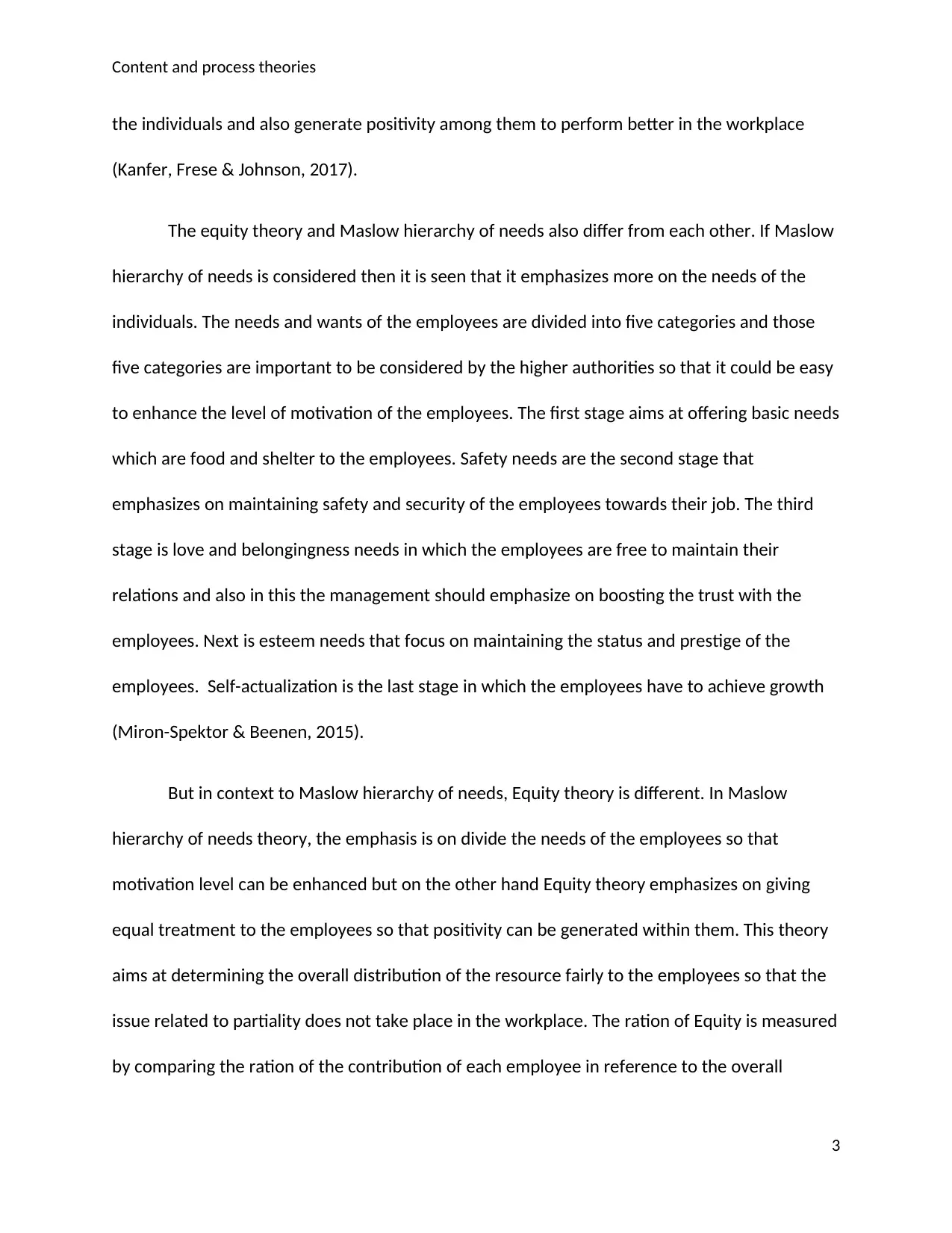
Content and process theories
the individuals and also generate positivity among them to perform better in the workplace
(Kanfer, Frese & Johnson, 2017).
The equity theory and Maslow hierarchy of needs also differ from each other. If Maslow
hierarchy of needs is considered then it is seen that it emphasizes more on the needs of the
individuals. The needs and wants of the employees are divided into five categories and those
five categories are important to be considered by the higher authorities so that it could be easy
to enhance the level of motivation of the employees. The first stage aims at offering basic needs
which are food and shelter to the employees. Safety needs are the second stage that
emphasizes on maintaining safety and security of the employees towards their job. The third
stage is love and belongingness needs in which the employees are free to maintain their
relations and also in this the management should emphasize on boosting the trust with the
employees. Next is esteem needs that focus on maintaining the status and prestige of the
employees. Self-actualization is the last stage in which the employees have to achieve growth
(Miron-Spektor & Beenen, 2015).
But in context to Maslow hierarchy of needs, Equity theory is different. In Maslow
hierarchy of needs theory, the emphasis is on divide the needs of the employees so that
motivation level can be enhanced but on the other hand Equity theory emphasizes on giving
equal treatment to the employees so that positivity can be generated within them. This theory
aims at determining the overall distribution of the resource fairly to the employees so that the
issue related to partiality does not take place in the workplace. The ration of Equity is measured
by comparing the ration of the contribution of each employee in reference to the overall
3
the individuals and also generate positivity among them to perform better in the workplace
(Kanfer, Frese & Johnson, 2017).
The equity theory and Maslow hierarchy of needs also differ from each other. If Maslow
hierarchy of needs is considered then it is seen that it emphasizes more on the needs of the
individuals. The needs and wants of the employees are divided into five categories and those
five categories are important to be considered by the higher authorities so that it could be easy
to enhance the level of motivation of the employees. The first stage aims at offering basic needs
which are food and shelter to the employees. Safety needs are the second stage that
emphasizes on maintaining safety and security of the employees towards their job. The third
stage is love and belongingness needs in which the employees are free to maintain their
relations and also in this the management should emphasize on boosting the trust with the
employees. Next is esteem needs that focus on maintaining the status and prestige of the
employees. Self-actualization is the last stage in which the employees have to achieve growth
(Miron-Spektor & Beenen, 2015).
But in context to Maslow hierarchy of needs, Equity theory is different. In Maslow
hierarchy of needs theory, the emphasis is on divide the needs of the employees so that
motivation level can be enhanced but on the other hand Equity theory emphasizes on giving
equal treatment to the employees so that positivity can be generated within them. This theory
aims at determining the overall distribution of the resource fairly to the employees so that the
issue related to partiality does not take place in the workplace. The ration of Equity is measured
by comparing the ration of the contribution of each employee in reference to the overall
3
⊘ This is a preview!⊘
Do you want full access?
Subscribe today to unlock all pages.

Trusted by 1+ million students worldwide
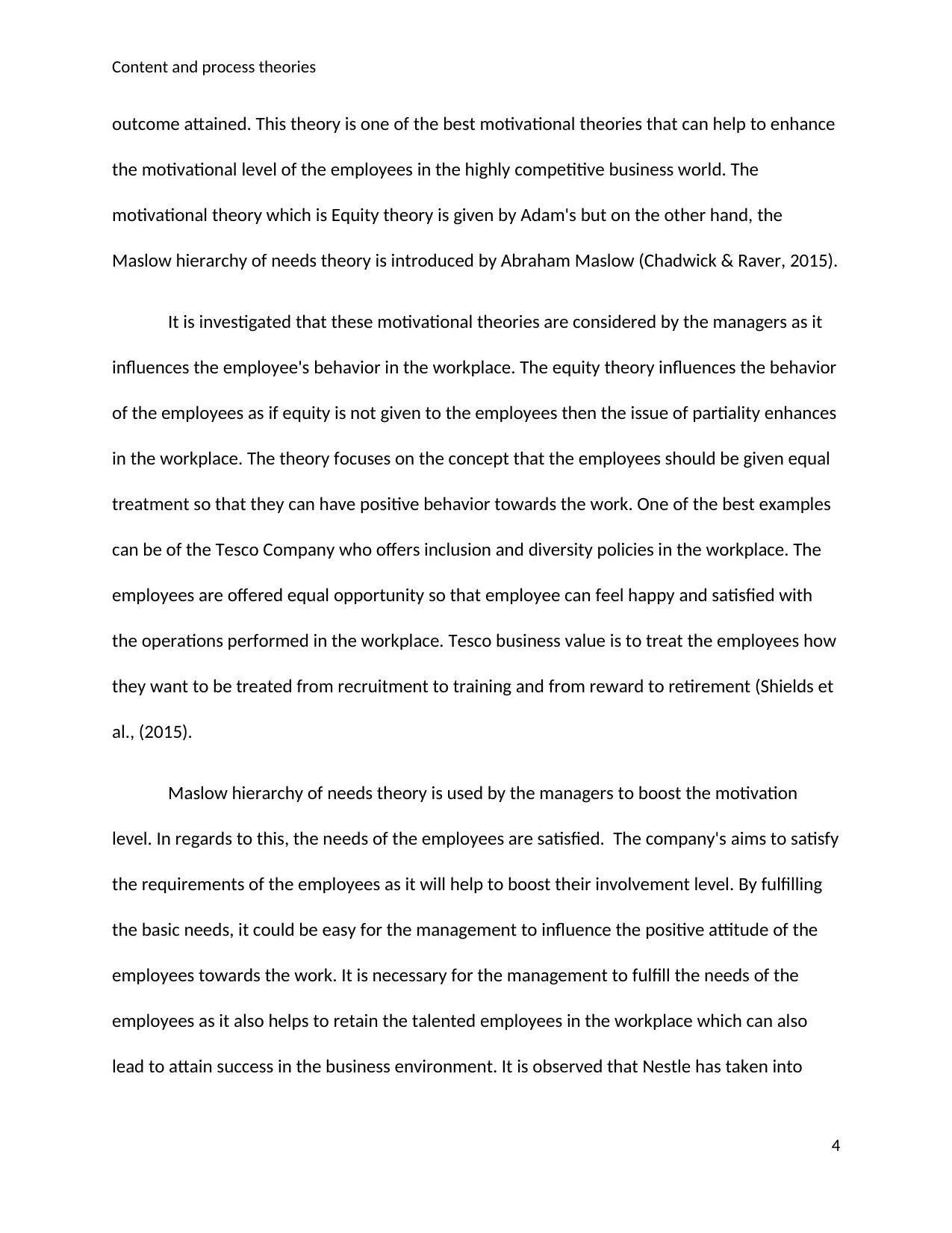
Content and process theories
outcome attained. This theory is one of the best motivational theories that can help to enhance
the motivational level of the employees in the highly competitive business world. The
motivational theory which is Equity theory is given by Adam's but on the other hand, the
Maslow hierarchy of needs theory is introduced by Abraham Maslow (Chadwick & Raver, 2015).
It is investigated that these motivational theories are considered by the managers as it
influences the employee's behavior in the workplace. The equity theory influences the behavior
of the employees as if equity is not given to the employees then the issue of partiality enhances
in the workplace. The theory focuses on the concept that the employees should be given equal
treatment so that they can have positive behavior towards the work. One of the best examples
can be of the Tesco Company who offers inclusion and diversity policies in the workplace. The
employees are offered equal opportunity so that employee can feel happy and satisfied with
the operations performed in the workplace. Tesco business value is to treat the employees how
they want to be treated from recruitment to training and from reward to retirement (Shields et
al., (2015).
Maslow hierarchy of needs theory is used by the managers to boost the motivation
level. In regards to this, the needs of the employees are satisfied. The company's aims to satisfy
the requirements of the employees as it will help to boost their involvement level. By fulfilling
the basic needs, it could be easy for the management to influence the positive attitude of the
employees towards the work. It is necessary for the management to fulfill the needs of the
employees as it also helps to retain the talented employees in the workplace which can also
lead to attain success in the business environment. It is observed that Nestle has taken into
4
outcome attained. This theory is one of the best motivational theories that can help to enhance
the motivational level of the employees in the highly competitive business world. The
motivational theory which is Equity theory is given by Adam's but on the other hand, the
Maslow hierarchy of needs theory is introduced by Abraham Maslow (Chadwick & Raver, 2015).
It is investigated that these motivational theories are considered by the managers as it
influences the employee's behavior in the workplace. The equity theory influences the behavior
of the employees as if equity is not given to the employees then the issue of partiality enhances
in the workplace. The theory focuses on the concept that the employees should be given equal
treatment so that they can have positive behavior towards the work. One of the best examples
can be of the Tesco Company who offers inclusion and diversity policies in the workplace. The
employees are offered equal opportunity so that employee can feel happy and satisfied with
the operations performed in the workplace. Tesco business value is to treat the employees how
they want to be treated from recruitment to training and from reward to retirement (Shields et
al., (2015).
Maslow hierarchy of needs theory is used by the managers to boost the motivation
level. In regards to this, the needs of the employees are satisfied. The company's aims to satisfy
the requirements of the employees as it will help to boost their involvement level. By fulfilling
the basic needs, it could be easy for the management to influence the positive attitude of the
employees towards the work. It is necessary for the management to fulfill the needs of the
employees as it also helps to retain the talented employees in the workplace which can also
lead to attain success in the business environment. It is observed that Nestle has taken into
4
Paraphrase This Document
Need a fresh take? Get an instant paraphrase of this document with our AI Paraphraser
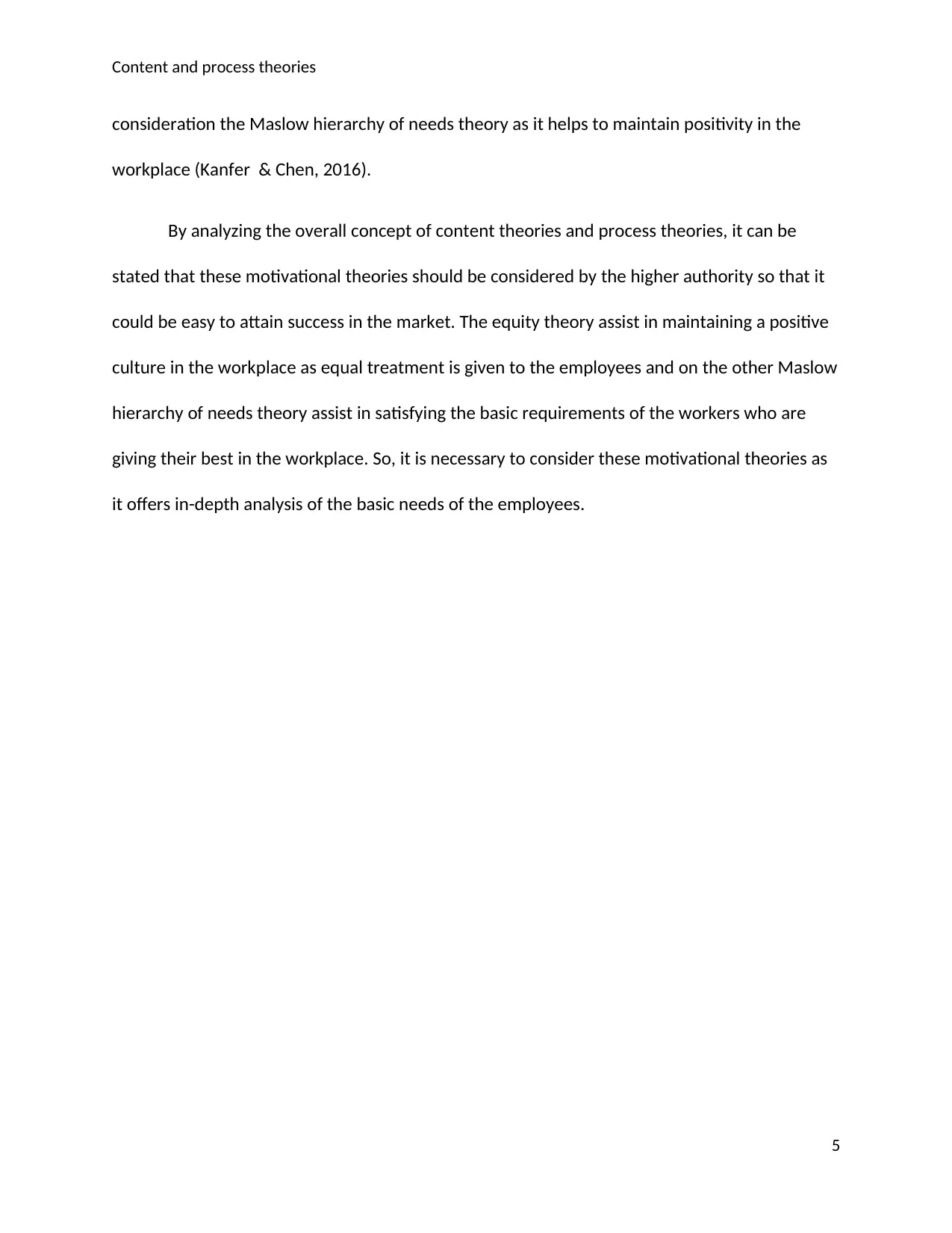
Content and process theories
consideration the Maslow hierarchy of needs theory as it helps to maintain positivity in the
workplace (Kanfer & Chen, 2016).
By analyzing the overall concept of content theories and process theories, it can be
stated that these motivational theories should be considered by the higher authority so that it
could be easy to attain success in the market. The equity theory assist in maintaining a positive
culture in the workplace as equal treatment is given to the employees and on the other Maslow
hierarchy of needs theory assist in satisfying the basic requirements of the workers who are
giving their best in the workplace. So, it is necessary to consider these motivational theories as
it offers in-depth analysis of the basic needs of the employees.
5
consideration the Maslow hierarchy of needs theory as it helps to maintain positivity in the
workplace (Kanfer & Chen, 2016).
By analyzing the overall concept of content theories and process theories, it can be
stated that these motivational theories should be considered by the higher authority so that it
could be easy to attain success in the market. The equity theory assist in maintaining a positive
culture in the workplace as equal treatment is given to the employees and on the other Maslow
hierarchy of needs theory assist in satisfying the basic requirements of the workers who are
giving their best in the workplace. So, it is necessary to consider these motivational theories as
it offers in-depth analysis of the basic needs of the employees.
5
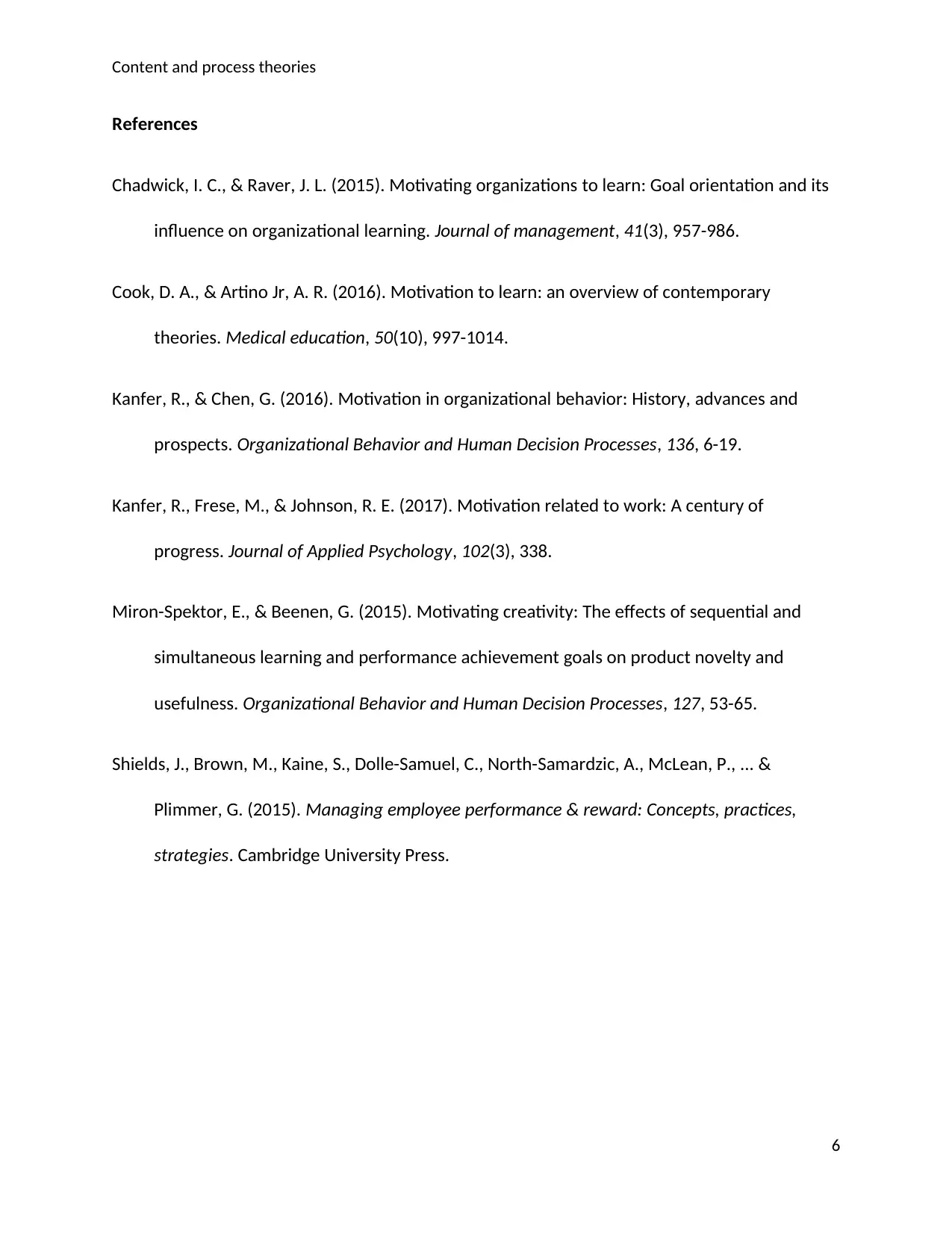
Content and process theories
References
Chadwick, I. C., & Raver, J. L. (2015). Motivating organizations to learn: Goal orientation and its
influence on organizational learning. Journal of management, 41(3), 957-986.
Cook, D. A., & Artino Jr, A. R. (2016). Motivation to learn: an overview of contemporary
theories. Medical education, 50(10), 997-1014.
Kanfer, R., & Chen, G. (2016). Motivation in organizational behavior: History, advances and
prospects. Organizational Behavior and Human Decision Processes, 136, 6-19.
Kanfer, R., Frese, M., & Johnson, R. E. (2017). Motivation related to work: A century of
progress. Journal of Applied Psychology, 102(3), 338.
Miron-Spektor, E., & Beenen, G. (2015). Motivating creativity: The effects of sequential and
simultaneous learning and performance achievement goals on product novelty and
usefulness. Organizational Behavior and Human Decision Processes, 127, 53-65.
Shields, J., Brown, M., Kaine, S., Dolle-Samuel, C., North-Samardzic, A., McLean, P., ... &
Plimmer, G. (2015). Managing employee performance & reward: Concepts, practices,
strategies. Cambridge University Press.
6
References
Chadwick, I. C., & Raver, J. L. (2015). Motivating organizations to learn: Goal orientation and its
influence on organizational learning. Journal of management, 41(3), 957-986.
Cook, D. A., & Artino Jr, A. R. (2016). Motivation to learn: an overview of contemporary
theories. Medical education, 50(10), 997-1014.
Kanfer, R., & Chen, G. (2016). Motivation in organizational behavior: History, advances and
prospects. Organizational Behavior and Human Decision Processes, 136, 6-19.
Kanfer, R., Frese, M., & Johnson, R. E. (2017). Motivation related to work: A century of
progress. Journal of Applied Psychology, 102(3), 338.
Miron-Spektor, E., & Beenen, G. (2015). Motivating creativity: The effects of sequential and
simultaneous learning and performance achievement goals on product novelty and
usefulness. Organizational Behavior and Human Decision Processes, 127, 53-65.
Shields, J., Brown, M., Kaine, S., Dolle-Samuel, C., North-Samardzic, A., McLean, P., ... &
Plimmer, G. (2015). Managing employee performance & reward: Concepts, practices,
strategies. Cambridge University Press.
6
⊘ This is a preview!⊘
Do you want full access?
Subscribe today to unlock all pages.

Trusted by 1+ million students worldwide
1 out of 6
Related Documents
Your All-in-One AI-Powered Toolkit for Academic Success.
+13062052269
info@desklib.com
Available 24*7 on WhatsApp / Email
![[object Object]](/_next/static/media/star-bottom.7253800d.svg)
Unlock your academic potential
Copyright © 2020–2025 A2Z Services. All Rights Reserved. Developed and managed by ZUCOL.





